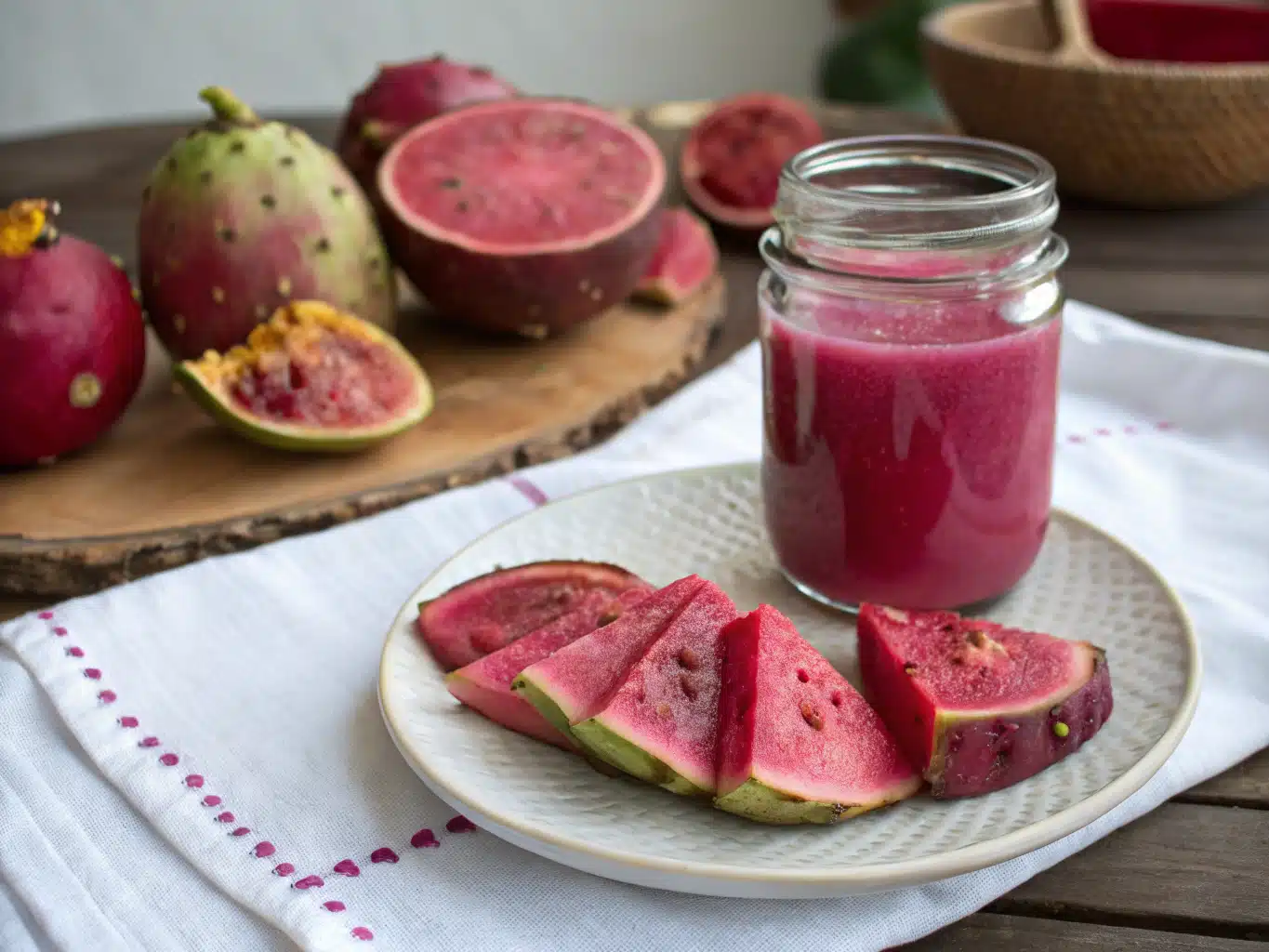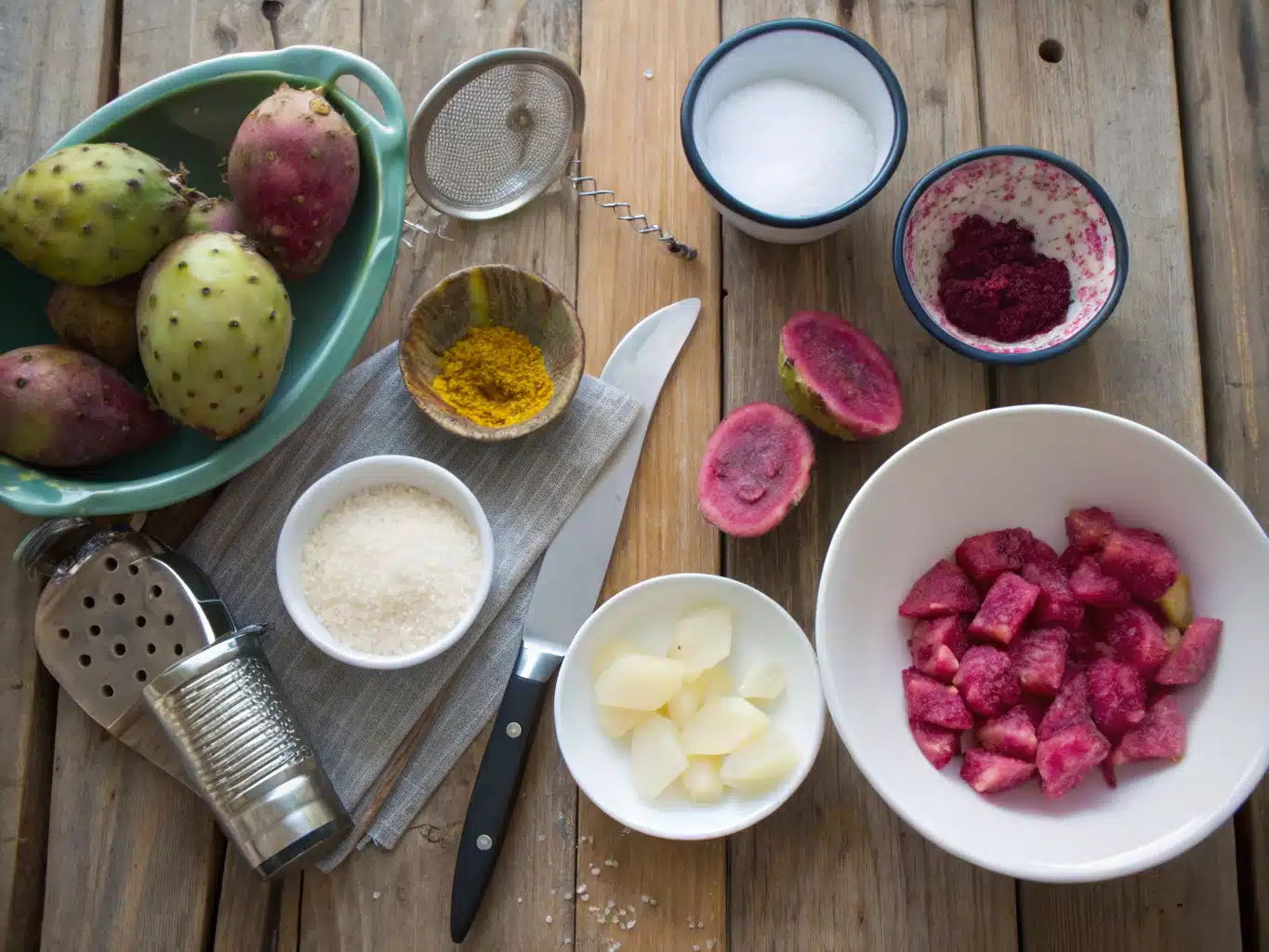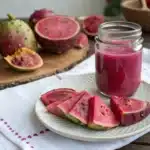
Table of Contents
If there’s one juice that took me by surprise, it’s prickly pear juice. I stumbled on it during my first summer in Portland, walking through a local co-op. I was searching for something new—something that tasted like sunshine in a glass—and I saw this neon magenta liquid staring back from the shelf.
One sip turned into a rabbit hole of experimenting with fresh prickly pears, and before long, my kitchen looked like a fruit stand meets chemistry lab. Now? It’s a seasonal ritual—and a vibrant reminder of how nature’s weirdest fruits can yield the brightest flavors. This guide is all about how to make prickly pear juice, why it’s worth your time, and how to get it right—spines, seeds, and all.
The Prickly Glow: Discovering Fresh Juice from Cactus Fruit
Prickly Pear Juice: Vibrant Flavor from the Desert
Prickly pear juice comes from the fruit of the Opuntia cactus, those paddle-shaped green plants laced with spines you might’ve passed hiking in the Southwest. The fruit—called “tunas” in Mexico—comes in deep pinks or greens and boasts a flavor somewhere between watermelon and bubble gum with a tart twist. You don’t need to be a chef or cactus expert to extract the goodness—just a bit of care, a few tools, and curiosity.
You can enjoy prickly pear juice as raw, freshly pressed liquid or incorporate it into bold recipes like prickly pear lemonade or cautiously sweet prickly pear preserves. I always describe it as sunshine bottled up. Its neon hue and candy-sweet vibe make it ideal for mocktails, smoothies, or even dressing up your oatmeal.
Growing Up with Garden-Fresh Ingredients
Back where I grew up in Northern California, our garden was the jewel of the backyard. We didn’t have prickly pears, but we sure embraced anything edible we could grow. My mom had a knack for transforming vegetables into vibrant dishes. That philosophy carries over to my approach with this juice: low-tech, deeply flavorful, and unfussy. While many treat cactus fruit recipes as exotic, it’s everyday stuff in Mexico and much of the Southwest—and there’s a reason it stands the test of time.
Thanks to its rise in popularity, prickly pear is now finding its way into more home kitchens. From nostalgic blends like prickly pear jelly to sweet-tart prickly pear jam, this fruit isn’t fussy as long as you respect the spines. If you’ve been looking for a plant-based refresh on your drink list, this one delivers color, flavor, and health in a single sip.
Making Fresh Prickly Pear Juice at Home
Ingredients List

To start crafting your own prickly pear juice, you don’t need a massive pantry—just quality ingredients. The fruit speaks for itself, but the right pairing will elevate its flavor.
| Ingredient | Substitution Tip |
|---|---|
| 4–5 ripe prickly pears | Use frozen or pre-skinned for convenience |
| 1–2 tablespoons fresh lemon juice | Try lime juice for a tangier tone |
| Filtered water (½ cup to adjust consistency) | Use coconut water for a twist |
| 1 tbsp agave or maple syrup (optional) | Skip for no-added-sugar version |
Timing: Quick Prep and Crafted Flavor
Making fresh prickly pear juice is surprisingly efficient. Here’s what to expect:
- Prep time: 15 minutes (mostly skinning and straining)
- Juicing + Mixing: 10 minutes
- Total time: 25 minutes
This is about 20% quicker than similar cold-pressed juices, which usually take longer due to pulp extraction. With a bit of practice, you might have your prickly pear juice ready before your cold brew finishes steeping.
Step-by-Step Instructions
- Glove up! The tiny invisible glochids (spines) on prickly pear skins can get under your skin—literally. Use tongs or gloves to handle and rinse them first.
- Carefully slice off both ends and make a shallow slit down the peel. Slide your thumb or a spoon under the skin and remove. Discard peel.
- Chop the peeled fruit and place in a blender or food processor.
- Blend until smooth, then pour through a fine mesh strainer or cheesecloth into a bowl or pitcher. Discard seeds and pulp.
- Stir in lemon juice, water, and optional sweetener until mixed.
- Chill or serve over ice immediately. The bold color pairs beautifully in cocktails or breakfast smoothies.
Interested in thickening the juice or turning leftovers into candy? Check out this rich guide to prickly pear candy recipes using similar ingredients.
Health Benefits and Unique Nutritional Profile
Good for Your Gut, Skin, and Entire Self
Prickly pear juice isn’t just a flavor bomb—it’s packed with fiber, antioxidants, and anti-inflammatory compounds. One cup delivers a handful of magnesium, vitamin C, and betalains—the pigments also found in beets. These have been shown to help reduce oxidative stress and support immune function.
In fact, according to a scientific review published in Molecules, cactus fruit like prickly pear is considered a potential functional food, meaning it offers health perks beyond basic nutrition. Its high fiber content supports digestion and gut health, while its antioxidant levels may aid in skin elasticity and wound healing.
Refreshing Hydration with a Bonus Boost
It’s not just nutrients—it’s hydration. Prickly pear juice contains natural electrolytes, making it an ideal drink post-hike, post-workout, or mid-heatwave. I started replacing sugary sports drinks with this luminous juice on hikes through Forest Park, and I felt better fueled and less heavy.
Recipes like Mexican prickly pear drinks traditionally mix the juice with lime, sal de gusano, or even spicy seasonings for balance. However you spin it, the hydration factor stays strong—and delicious.
Beyond The Juice: How Else Can You Use Prickly Pear?
From Juice to Jelly: Sweet Spreads and More
If you feel inspired to explore further, prickly pear lends itself to a wide range of recipes beyond a simple pour. Homemade prickly pear cactus syrup can enliven desserts or drinks, while incorporating the pulp into breakfast ideas like compotes and jams adds texture and color.
Storage-wise, homemade prickly pear juice lasts three to four days in the fridge, but I often freeze it into cubes for later use in smoothies or teas. It’s become my secret weapon in summer recipes, especially when paired with herbs like mint or basil.
Flavor Fusion: Culinary Pairings & Plant-Based Inspiration
Because prickly pear is both sweet and slightly tart, it plays well with contrasting flavors. Here are a few tasty pairings:
| Pairs Well With | Why It Works |
|---|---|
| Citrus (lemon, lime) | Enhances tang while balancing sweetness |
| Chili or Tajín spice | Adds warmth and depth to the fruit |
| Mint or basil | Brings herbaceous freshness |
Once you get creative, you might just find ways to weave prickly pear juice into dressings, tangy glazes, or even cocktail shrubs.
Frequently Asked Questions (FAQs)
How do you juice prickly pear fruit?
Use tongs or gloves to safely remove the skin first, then blend the peeled fruit. Strain through mesh or cheesecloth to separate the seeds and pulp from the juice. It’s fast, simple, and highly flavorful.
What are the benefits of prickly pear juice?
It offers dietary fiber, magnesium, and antioxidants like betalains that support immune health and reduce inflammation. Many also report better hydration and digestion.
Can you drink prickly pear juice raw?
Absolutely. Freshly juiced prickly pear can be enjoyed raw and tastes sweet like watermelon with a subtle tart finish. Just be sure to strain it well and keep it refrigerated.
Do you need to remove spines before juicing?
Yes! Always wear gloves or use tongs. The spines on the skin (glochids) are hard to see but can cause irritation. Once peeled, the fruit is entirely spine-free and safe to consume.
Conclusion
Prickly pear juice isn’t just something you try—it becomes something you crave. From its jaw-dropping color to the smooth, fruity flavor that surprises your palate, it’s plant-based magic in every pour. I’ve watched it transform curious first-timers into bright juice evangelists, just like I was that first hot day in Portland. Whether you’re blending it into preserves or simply sipping it over ice, this underrated cactus fruit delivers nutrition, hydration, and flavor all at once. So roll up your sleeves, snap on those gloves, and start juicing. Because the desert hides some of the juiciest secrets.
Print
Prickly Pear Juice: How to Make It, Why You’ll Love It, and What to Know
- Total Time: 25 minutes
- Yield: 2–3 servings 1x
- Diet: Vegan
Description
A neon-pink, sweet-tart juice made from cactus fruit that hydrates, nourishes, and surprises with flavor. Easy, vibrant, and rich in antioxidants.
Ingredients
4–5 ripe prickly pears
1–2 tablespoons fresh lemon juice
½ cup filtered water
1 tbsp agave or maple syrup (optional)
Instructions
1. Glove up and rinse prickly pears to remove glochids.
2. Cut off ends and slit the peel; remove the skin.
3. Chop fruit and blend until smooth.
4. Strain through a mesh sieve or cheesecloth to remove seeds and pulp.
5. Stir in lemon juice, water, and sweetener.
6. Chill or serve over ice immediately.
Notes
Use coconut water instead of filtered water for a twist.
Freeze juice into cubes for smoothies or teas.
Pairs well with mint, basil, citrus, or chili seasoning.
- Prep Time: 15 minutes
- Cook Time: 10 minutes
- Category: Drink
- Method: Blending
- Cuisine: Southwestern
Nutrition
- Serving Size: 1 cup
- Calories: 70
- Sugar: 12g
- Sodium: 5mg
- Fat: 0g
- Saturated Fat: 0g
- Unsaturated Fat: 0g
- Trans Fat: 0g
- Carbohydrates: 17g
- Fiber: 3g
- Protein: 1g
- Cholesterol: 0mg
Keywords: prickly pear, cactus juice, refreshing, vegan, plant-based, summer drink
